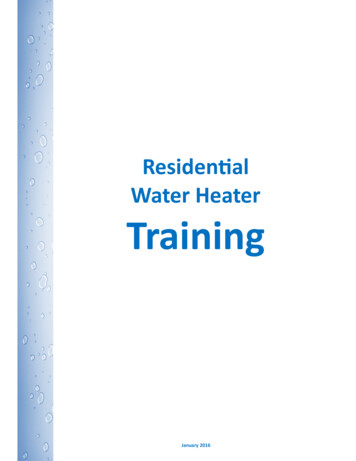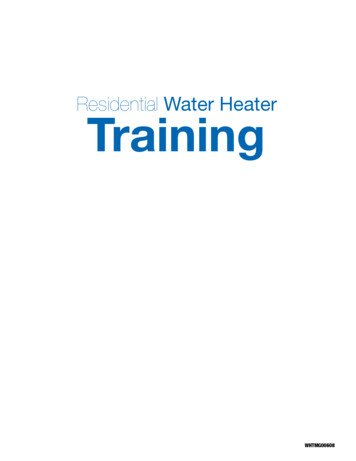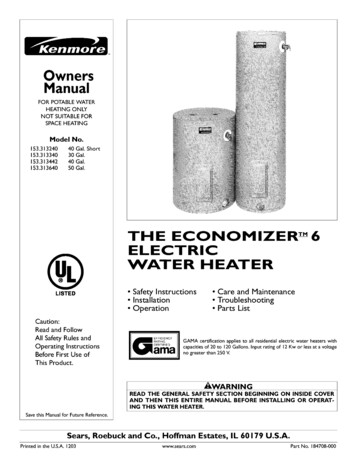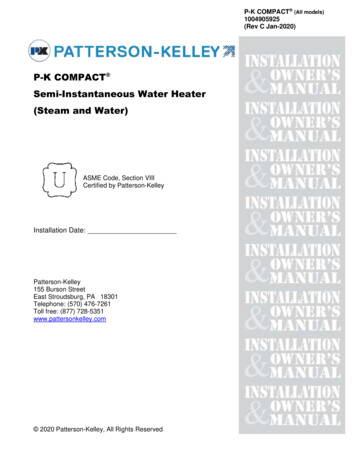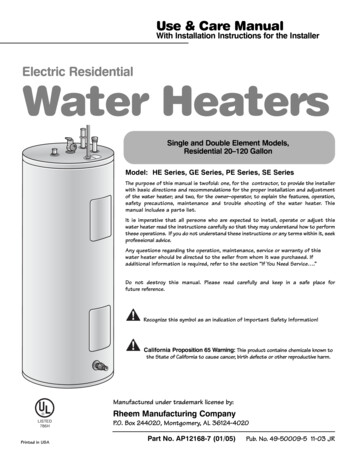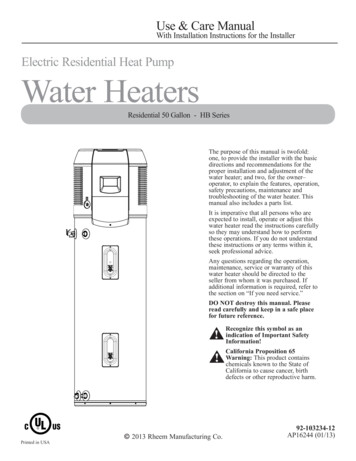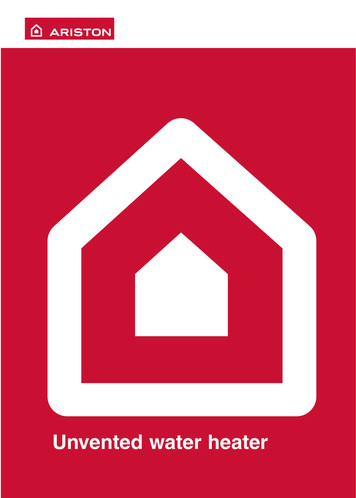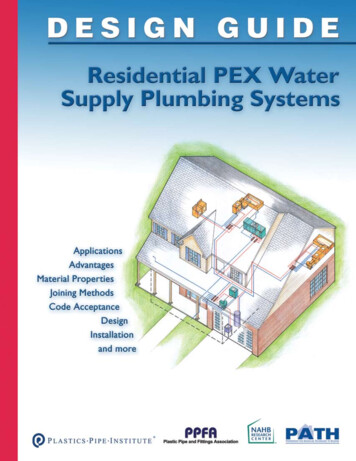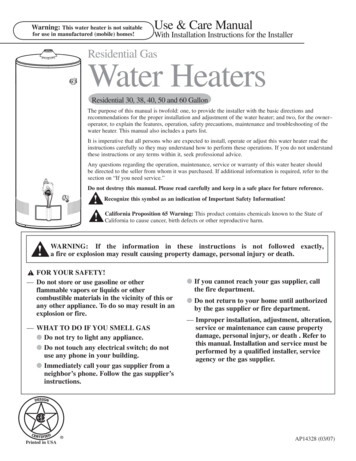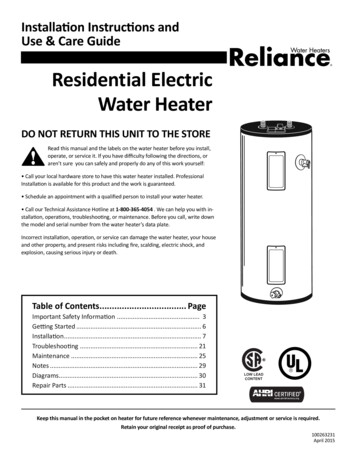
Transcription
Installa on Instruc ons andUse & Care GuideResidential ElectricWater HeaterDO NOT RETURN THIS UNIT TO THE STORERead this manual and the labels on the water heater before you install,operate, or service it. If you have difficulty following the direc ons, oraren’t sure you can safely and properly do any of this work yourself: Call your local hardware store to have this water heater installed. ProfessionalInstalla on is available for this product and the work is guaranteed. Schedule an appointment with a qualified person to install your water heater. Call our Technical Assistance Hotline at 1-800-365-4054 . We can help you with installa on, opera ons, troubleshoo ng, or maintenance. Before you call, write downthe model and serial number from the water heater’s data plate.Incorrect installa on, opera on, or service can damage the water heater, your houseand other property, and present risks including fire, scalding, electric shock, andexplosion, causing serious injury or death.Table of Contents. PageImportant Safety Informa on . 3Ge ng Started . 6Installa on . 7Troubleshoo ng . 21Maintenance . 25Notes . 29Diagrams. 30Repair Parts . 31LOW LEADCONTENTKeep this manual in the pocket on heater for future reference whenever maintenance, adjustment or service is required.Retain your original receipt as proof of purchase.100263231April 2015
COMPLETED INSTALLATION TYPICALWatershut aljunc onboxElectronic Thermostatand Upper ement andThermostataccessDrain pandischargepipeDrainvalveDrain panDrain
Read and follow all safety messages and instruc ons inthis manual.This is the safety alert symbol. It is used to alert you topoten al physical injury hazards. Obey all safety messages that follow this symbol to avoid possible propertydamage, serious injury or death. Do not remove anypermanent instruc ons, labels, or the data plate from either the outside ofthe water heater or on the inside of the access panels. Keep this manualnear the water heater.Important informa on to keepFill out this sec on and keep thismanual in the pocket of the waterheater for reference.Date Puchased:Model number:Serial number:DANGERDANGER indicates hazardoussitua on that, if not avoided, willresult in death or serious injury.WARNINGWARNING indicates a hazardoussitua on that, if not avoided, couldresult in death or serious injury.CAUTIONCAUTION indicates a hazardoussitua on that, if not avoided, couldresult in minor or moderate injury.NOTICEMaintenance performed:*Date:NOTICE indicates prac ces notrelated to physical injury.The California Safe Drinking Water and Toxic Enforcement Act requires theGovernor of California to publish a list of substances known to the State ofCalifornia to cause cancer, birth defects, or other reproductive harm, andrequires businesses to warn of potential exposure to such substances.WARNING! This product contains one or more chemicals known to theState of California to cause cancer, birth defects, or other reproductive harm.This appliance can cause low-level exposure to some of the substancesincluded in the act.*Drain and flush tank and remove andinspect anode rod a er first six monthsof opera on and at least annuallytherea er. Operate the Temperatureand Pressure Relief Valve (T&P) annually and inspect T&P valve every 2-4years (see the label on the T&P valve formaintenance schedule). See the Maintenance sec on for more informa onabout maintaining this water heater.Residen al Electric Water Heater Use and Care Guide 3SAFETYIMPORTANT SAFETY INFORMATION
SAFETYIMPORTANT SAFETY INFORMATIONTo reduce the risk of propertydamage, serious injury or death,read and follow the precau ons below,all labels on the water heater, andthe safety messages and instruc onsthroughout this manual.RISKS DURING INSTALLATIONAND MAINTENANCEElectric Shock RiskContact with the electricalparts in the junction box andbehind the access doors canresult in severe injury or death fromelectrical shock: Disconnect power by opening the circuit breaker orremoving the fuses beforeinstalling or servicing.Use a non-contact circuittester to confirm that poweris off before working on ornear any electrical parts.Replace the junction boxcover and access doors afterservicing.Li ing RiskWARNING! Thewater heater is heavy.Follow these precauons to reduce therisk of property damage, injuries fromli ing or impact injuries from droppingthe water heater. Use at least two people to li thewater heater. Be sure you both have a good gripbefore li ing. Use an appliance dolly or handtruck to move the water heater.RISKS DURING OPERATIONScalding RiskThis water heatercan make water hotenough to causesevere burns instantly, resulting insevere injury or death.Feel water before bathing or showering. To reduce the risk of scalding,install Thermostatic Mixing Valves(temperature limiting valves) at eachpoint-of-use. These valves automatically mix hot and cold water to limitthe temperature at the tap. Mixingvalves are available from local hardware stores. Follow manufacturer’sinstructions for installation andadjustment of the valves.The thermostat(s) on this waterheater have been factory set toapproximately 120 F to reduce therisk of scalding. Higher temperaturesincrease the risk of scalding, buteven at 120 F, hot water can scald.If you choose a higher temperature,Thermostatic Mixing Valves locatedat each point-of-use are particularlyimportant to help avoid scalding.TemperatureTime to Producea Serious Burn120 F (49 C)More than 5 minutes125 F (52 C)1½ to 2 minutes130 F (54 C)About 30 seconds135 F (57 C)About 10 seconds140 F (60 C)Less than 5 seconds145 F (63 C)Less than 3 seconds150 F (66 C)About 1½ seconds155 F (68 C)About 1 second4 Residen al Electric Water Heater Use and Care GuideFor informa on about changing thefactory thermostat se ng(s), refer tothe “Adjus ng Temperature” sec on inthis manual (“Step 10” on page 15).Even if you set the water heaterthermostat(s) to a low se ng, highertemperatures may occur in certaincircumstances:In some cases, repeated small draws ofwater can cause the hot and cold waterin the tank to “stack” in layers. If thishappens, the water can be as much asthirty degrees ho er than the thermostat se ng. This temperature varia onis the result of your usage pa ern andis not a malfunc on.Water temperature will be ho er ifsomeone adjusted the thermostat(s) toa higher se ng.Problems with the thermostat(s),or other malfunc ons may result inhigher than expected water temperatures.If the water heater is in a hot environment, the water in the tank canbecome as hot as the surrounding air,regardless of the thermostat se ng.If the water supplied to the waterheater is pre-heated (for example, bya solar system) the temperature in thetank may be higher than the waterheater’s thermostat se ng.To reduce the risk of unusually hot water reaching the fixtures in the house,install Thermosta c Mixing Valves ateach point-of-use.If anyone in your home is at par cularrisk of scalding (for example, the elderly, children, or people with disabili es)or if there is a local code or state lawrequiring a certain water temperature
According to a na onal standardAmerican Society of San ary Engineering (ASSE 1070) and most local plumbingcodes, the water heater’s thermostatshould not be used as the sole means toregulate water temperature and avoidscalds.Properly adjusted Thermosta c MixingValves installed at each point-of-use allow you to set the tank temperature toa higher se ng without increasing riskof scalds. A higher temperature se ngallows the tank to provide much morehot water and can help provide properwater temperatures for appliances suchas dishwashers and washing machines.Higher tank temperatures (140 F)also kill bacteria that cause a condion known as “smelly water” and canreduce the levels of bacteria that causewater-borne diseases.Water Contamina on RiskDo not use chemicals that could contaminate the potable water supply. Donot use piping that has been treatedwith chromates, boiler seal, or otherchemicals.Fire RiskTo reduce the risk of afire that could destroyyour home and seriously injure or kill people: Do not store things that can burneasily such as paper or clothes nextto the water heater. Be sure the junction box cover andthe access door covers are in place.These covers keep debris from entering and potentially being ignited,and help keep any internal fires fromspreading. Keep the water heater from becoming wet. Immediately shut the waterheater off and have it inspected by aqualified person if you find that thewiring, thermostat(s) or surrounding insulation have been exposed towater in any way (e.g., leaks fromplumbing, leaks from the water heater itself can damage property andcould cause a fire risk). If the waterheater is subjected to flood conditions or the thermostat(s) have beensubmerged in water, the entire waterheater must be replaced. Make electrical connections proprly,according to the instructions on page14. Use 10 gauge solid copper wire.Use a UL listed or CSA approvedstrain relief. Connect ground wire togreen ground screw.Explosion RiskHigh temperatures andpressures in the waterheater tank can cause anexplosion resul ng in propertydamage, serious injury or death. Anew Temperature and Pressure (T&P)Relief Valve is included with your waterheater to reduce risk of explosion bydischarging hot water. Addi onaltemperature and pressure protec veequipment may be required by localcodes.Maintain the T&P Relief Valve properly.Follow the maintenance instruc onsprovided by the manufacturer of theT&P Relief Valve (label a ached to T&PRelief Valve) and the procedure thatstarts on page 28.An explosion could occur if the T&PRelief Valve or discharge pipe isblocked. Do not cap or plug the T&PRelief Valve or discharge pipe.Fire and Explosion Risk if Hot Water isNot Used for Two Weeks or MoreCAUTION! Hydrogen gas builds up ina hot water system when it is not usedfor a long period (two weeks or more).Hydrogen gas is extremely flammable.If the hot water system has not beenused for two weeks or more, open ahot water faucet for several minutes atthe kitchen sink before using any electrical appliances connected to the hotwater system. Do not smoke or havean open flame or other igni on sourcenear the faucet while it is open.A na onally recognized tes ng laboratory maintains periodic inspec on ofthe valve produc on process and cer fies that it meets the requirementsfor Relief Valves for Hot Water SupplySystems, ANSI Z21.22. The T&P ReliefValve’s relief pressure must not exceedthe working pressure ra ng of the water heater as stated on the ra ng plate.Residen al Electric Water Heater Use and Care Guide 5SAFETYat the hot water tap, then these precauons are par cularly important.
GETTING STARTEDReview all of the instruc onsbefore you begin work.If you aren’t sure that youcan safely and properly do this workyourself, call your local hardware storeto arrange for Professional Installa on(you may also call a qualified personof your choice, such as a licensedplumber or electrician, to have thework done). Improper installa on candamage the water heater, your homeand other property, and can presentrisks of serious injury or death.GETTING STARTED1Figure 1 - Flexible connectors use compressionfi ngs and do not require soldering.Figure 2 - Use a non-contact circuit tester toinsure that the power is off before you work ona circuit.Figure 3 - Install a Pressure Reducing Valve set to50 to 60 PSI.Check with your local andstate authori es for any localor state codes that apply toyour area. In the absence of local andstate codes, follow Na onal FireProtec on Associa on (NFPA-70) andthe current edi ons of the Na onalElectric Code (NEC) and the Internaonal Plumbing Code (IPC). Theinstruc ons in this manual comply withna onal codes, but the installer isresponsible for complying with localcodes.2Massachuse s code requires this water heater to be installed in accordancewith Massachuse s 248-CMR 2.00 and248-CMR 5.00: State Plumbing Code.Other local and state authori es mayhave similar requirements or othercodes applicable to the installa on ofthis water heater.3Before you start, be sure youhave, and know how to use, thefollowing tools and supplies: Plumbing tools and supplies appropriatefor the type of water pipes in your home Threaded connectors (figure 1) forthe cold and hot water pipes For homes plumbed with plas cpipe, use threaded connectors6 Residen al Electric Water Heater Use and Care Guidesuitable for the specific type ofplas c pipe used: CPVC and PEX(cross-linked polyethylene). Donot use PVC pipe. For homes with copper pipes,you may purchase connector kitswith compression fi ngs thatdon’t require soldering (figure 1).Compression fi ngs are easierto install than soldering copperpipes. Teflon tape or pipe joint compoundapproved for potable water Tools to make the electrical connecons (for example, screwdrivers, wirestrippers) Non-Contact circuit tester to checkfor power (figure 2) Water Pressure Gauge (see nextpage, figure 4)Recommended Accessories: Suitable drain pan (see page 8, figure 6) Automa c leak detec on and shutoff device Pressure Reducing Valve (figure 3) Thermal Expansion Tank (see nextpage, figure 5) Point-of-use Thermosta c MixingValves (see page 8, figure 7)
INSTALLATION Water pressureincr
to the water heater. Be sure the junction box cover and the access door covers are in place. These covers keep debris from enter-ing and potentially being ignited, and help keep any internal fires from spreading. Keep the water heater from becom-ing wet. Immediately shut the water heater off
